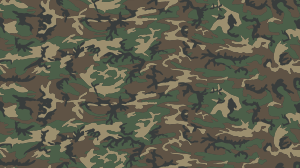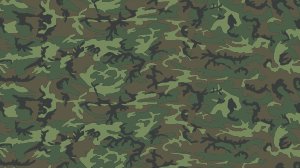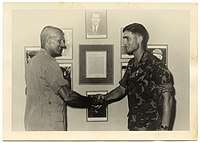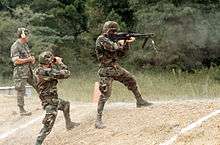ERDL pattern
The ERDL pattern, also known as the Leaf pattern,[2] is a camouflage pattern developed by the United States Army at its Engineer Research & Development Laboratories (ERDL) in 1948.[3][4] It was not used until the Vietnam War, when it was issued to elite reconnaissance and special operations units beginning early 1967.[5][6]
| ERDL pattern | |
|---|---|
  The two variants of the ERDL pattern: Brown-dominant "highland" (top) and Green-dominant "lowland" (bottom) | |
| Type | Military camouflage pattern |
| Place of origin | United States of America |
| Service history | |
| In service | 1948–1988 (U.S. military service) |
| Used by | U.S. Marine Corps (former) U.S. Air Force (former) U.S. Army (former) See Users (for other non-U.S. users) |
| Wars | Vietnam War Syrian Civil War |
| Production history | |
| Designer | United States Army Engineer Research and Development Laboratory under Alvin O. Ramsley[1] and John Hopkings[2] |
| Designed | 1948 |
| Produced | 1948–1979 |
The pattern consists of four colors printed in an interlocking pattern. It was initially produced in a lime-dominant colorway, consisting of large organic shapes in mid green and brown, black ‘branches’, and light green ‘leaf highlights’. Shortly thereafter a brown-dominant scheme (with the light green replaced by light tan) was manufactured. The two patterns are also unofficially known as "Lowland" and "Highland" ERDL, respectively.[7]
History


The United States Marine Corps (USMC) adopted the green "Lowland" version as standard issue in South Vietnam from 1968, and later the U.S. Army introduced it on a wide scale in Southeast Asia.
The ERDL-pattern combat uniform was identical in cut to the OG-107 jungle fatigues it was issued alongside.[8] It was common for Marines to wear mixes of ERDL and OG-107 jungle fatigues, which was authorized owing to periodic shortages. Australian and New Zealand SAS members were also issued U.S.-spec tropical combat uniforms in ERDL during their time in the Vietnam War. By the end of the Vietnam War, U.S. servicemen wore camouflage combat dress as the norm.[9]
Following the withdrawal of the U.S. military from South Vietnam in 1973, the U.S. Army no longer routinely issued camouflage clothing. The 1st Battalion, 13th Infantry Regiment wore the ERDL-leaf pattern as an experiment in the early 1970s from January 1973 to 1974[10] in Baumholder, Germany. Soldiers in the 1st and 2d Ranger Battalions (1/75 & 2/75 Ranger [Airborne]) received ERDL jungle fatigues of all three varieties as organizational issue, and during this same period U.S. Army Special Forces Groups, the U.S. Army John F. Kennedy Special Warfare Center and School, the 82d Airborne Division and 36th Airborne Brigade (Texas National Guard) were issued the ERDL jungle fatigues until replaced by BDUs. 1st Battalion (mechanized), 41st Infantry, wore ERDL unfiforms in 1974 and 1975. This unit was the "tip of the spear" for the Second Armored Division with assignments at Ft. Hood, Texas and Hohenfels, West Germany. In 1976, the Marines obtained the leftover Vietnam War-era ERDL pattern uniforms which became general issue, replacing the solid OG-107 sateen utility/fatigue uniform. As there was never an ERDL pattern Marine-style utility cap, the Marines continued to wear the solid OG utility hat until the adoption of the BDU pattern. The Army had a similar problem, while most units issued ERDL pattern uniforms wore a beret in garrison, the M1951 field cap or patrol cap worn in the field by Ranger and Special Forces units was a solid OG. However there was a ERDL pattern boonie hat. The uniform was to be used to equip the United States Rapid Deployment Force (RDF) while on tropical missions. Photographs during the 1979 Iranian hostage crisis show U.S. marines guarding the U.S. embassy wearing the RDF version ERDL uniforms when they were taken hostage by Iranian revolutionaries.
It was not until 1981 that the Army approved another camouflaged uniform. That year it officially introduced the M81 Battle Dress Uniform (BDU) in Woodland pattern,[11] an enlarged and slightly altered version of ERDL, to supply all arms of the U.S. military. The last batches of the ERDL-patterned fatigues saw service into the 1980s, notably during Operation Eagle Claw, peacekeeping operations in Beirut, and the invasion of Grenada.
Samples of the ERDL pattern acquired during the Vietnam War were shipped to the USSR, where it used as the basis for making the TTsKO camouflage pattern.
Garment types, designs, and use in Southeast Asia (1967–72)
The ERDL pattern was used on official and unofficial U.S. military garments in Southeast Asia (SEA), in both ground and aviation garment versions, from 1967 to the war's end. Early production on the ERDL ran into problems due to roller slippage, which results in inconsistencies with the patterns that were printed.[4]
On official ground combat garments, the ERDL pattern was first applied to the third model Tropical Combat Uniform around 1967, and was printed onto a lightweight cotton poplin textile material. This poplin uniform was very short-lived, but it did see combat use in SEA by various U.S. special operations and some other units. Soon afterward, the ERDL pattern was printed onto the standard rip-stop cotton textile material. This ERDL rip-stop cotton Tropical Combat Uniform version thus saw wide use in SEA after 1968, with special operations units and also regular units, especially as ground combat operations continued throughout the war up to late 1972.
On official aviation combat garments, the ERDL pattern was used on the USAF Type K-2B flying coveralls, in a cotton poplin textile version. The USAF ERDL coveralls saw some use in SEA from 1967–69, until replaced by Nomex coveralls in 1970. The U.S. Navy also produced an official ERDL aviation garment in their MIL-C-5390G pattern, produced in a cotton twill textile. These Navy ERDL coveralls saw very limited SEA use from 1967–68, as their Nomex coveralls were already in use.
On unofficial and commercial garments, the ERDL pattern was copied and used by U.S. commercial textile manufacturers in the late 1960s, and applied to various commercial camouflage garments for hunting or unofficial military use. Some commercial ERDL garment examples were made using cotton poplin material, and others were made in the standard rip-stop cotton material. Many commercial ERDL garment examples of the time were made in the pattern mirroring the standard OG-107 fatigue uniforms, with a standard tucked-in shirt, and conventional trousers design. These commercial ERDL OG-107 fatigue-style garments did see some combat use in SEA, such as with U.S. Navy tactical jet aviators in the 1968 timeframe. Some USAF aviators also purchased locally tailor-made ERDL garments for combat and off-duty use. Additionally, some tropical combat uniforms were made by local tailors in the ERDL rip-stop material, which were particularly useful when a classified mission required the use of 'sanitized' or 'sterile' apparel, and equipment.
Users
Current


Former
.svg.png)






.svg.png)
.svg.png)
References
- https://www.complex.com/style/2011/09/the-complex-guide-to-camo/erdl-camo
- https://blog.elmc.co/view-post/marine-corps-camo
- http://www.vietnamgear.com/dictionary/erdl.aspx
- Dougherty 2017, p. 63.
- Blechman/Newman, Hardy/Alex (2004). DPM: Disruptive Pattern Material. Department of Publications, Maharishi. ISBN 0-9543404-0-X.
- Tom Vanderbilt, "The Army's new camouflage", Slate Magazine
- Mark's Asian Camo Uniforms
- Vietnam - Equipment and Uniform
- Newark, Tim (2007). Camouflage. Thames & Hudson. ISBN 978-0-500-51347-7.
- "1st Bn 13th Inf Stands Out as Div Unit", The Arrow (19 November 1973), p. VI
- Christine O. Hardyman, ed. (1988). "Chapter 7: Support Services". Department of the Army Historical Summary FY 1981. United States Army Center of Military History.
- https://web.archive.org/web/20200327072705/https://apps.dtic.mil/dtic/tr/fulltext/u2/1059969.pdf
- https://www.joint-forces.com/features/kit-camo/31575-czech-vz95-leaf-pattern-43rd-airborne-battalion
- http://armamentresearch.com/a-snapshot-of-camouflage-patterns-in-syria/
- https://www.awm.gov.au/collection/C993358
- Conboy 1991, p. 61.
- 'Training in the jungle', URL: https://vietnamwar.govt.nz/photo/camoflage-action, (Ministry for Culture and Heritage), updated 25-Oct-2013
- 'Helen Kesha welcomes troops - 161 Battery parade', URL: https://vietnamwar.govt.nz/photo/helen-kesha-welcomes-troops-161-battery-parade, (Ministry for Culture and Heritage), updated 11-Jul-2013
- https://web.archive.org/web/20191208111130/http://camouniforms.net/index.php/southeast-asia/singapore/singapore-leaf-pattern/519-2013-08-26-03-54-311
- https://web.archive.org/web/20191208111132/http://camouniforms.net/index.php/southeast-asia/singapore/singapore-leaf-pattern/518-1984-singapore-leaf-pattern-jacket
- https://www.itstactical.com/gearcom/camouflage/little-known-facts-and-history-about-camouflage-of-the-western-world-2/
- https://web.archive.org/web/20191208111059/http://camouniforms.net/index.php/southeast-asia/south-vietnam/invisible-erdl/125-invisible-erdl-shirt
- https://web.archive.org/web/20191208111101/http://camouniforms.net/index.php/asia/taiwan/taiwan-leaf-pattern/1064-taiwan-horizontal-leaf-pattern-jacket
- https://web.archive.org/web/20191208113828/http://camouniforms.net/index.php/asia/taiwan/taiwan-leaf-pattern/1065-2015-01-16-07-25-32
- https://web.archive.org/web/20191208113537/http://camouniforms.net/index.php/southeast-asia/thailand/thai-leaf-pattern/530-thai-leaf-pattern-ripstop-jacket
- https://web.archive.org/web/20191208115418/http://camouniforms.net/index.php/southeast-asia/thailand/thai-leaf-pattern/531-2013-08-29-12-30-48
- Conboy 1991, p. 49.
- Pitta 1983, p. 54.
- Pitta 1983, p. 55.
- Camouflage Facts Archived 2006-05-24 at the Wayback Machine, Delta Gear, Inc.
Further reading
- Dougherty, Martin (2017). Camouflage at War: An Illustrated Guide from 1914 to the Present Day. London, UK: Amber Books. ISBN 978-1782744986.
- Conboy, Kenneth (1991). South-East Asian Special Forces. Osprey Publishing. ISBN 978-1855321069.
- Pitta, Robert (27 May 1993). South African Special Forces. Osprey Publishing. ISBN 978-1855322943.
- Stanton, Shelby (1989). US Army Uniforms of the Vietnam War. Harrisburg, Pennsylvania: Stackpole Books. ISBN 978-0811725842.
External links

.jpg)